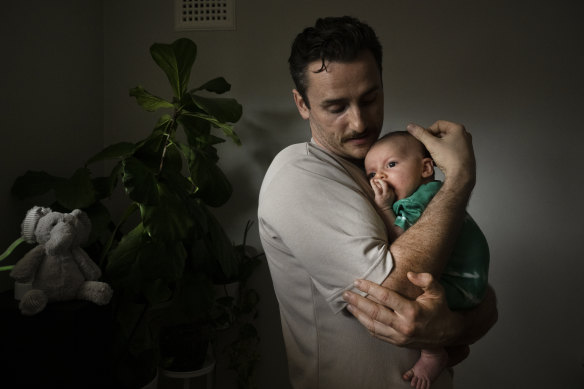Save articles for later
Add articles to your saved list and come back to them any time.
Employers must treat paternity leave as seriously as when women take time off work for parenting responsibilities, advocates say, with equal entitlement policies only the first step to men sharing more of the load.
A new report comparing attitudes towards parental leave found almost nine in 10 Australian men acknowledged they had equal responsibility for caring for their children, despite the overwhelming majority of parental leave being taken by women.
New dad Oliver Begg took a month off when five-week-old Iggy was born.Credit: Louise Kennerley
In 2022-23, more than 170,200 Australian women accessed government-funded paid parental leave compared with 1020 men. An additional 87,895 men and 745 women accessed the now defunct two-week “dad and partner pay” payment for secondary carers, which has since been made part of a family’s parental leave allotment.
The figures show women accessing any government-funded parenting leave outnumbered men by almost two to one.
Meanwhile, although the Workplace Gender Equality Agency’s annual employer census found in 2023 the proportion of employers offering universally available leave rose by 9 per cent, to 33 per cent, men accounted for just 14 per cent of all paid primary carer’s parental leave, a marginal increase from 2022 of 0.6 per cent.
The Fathering Project chief executive Kati Gapaillard said gender stereotypes about men being breadwinners, the impact of the gender pay gap and men’s higher salaries meant fathers were continuing to choose to work through their child’s early months.
“The troubling reality is that men are really not utilising parental leave. In Australia, our utilisation is concerningly low,” she said.
The Fathering Project contributed the Australian component of US gender equity agency Equimundo’s 2023 State of the World’s Fathers report, commissioning survey research led by the Telethon Kids Institute on attitudes towards taking paid parental leave.
Of the men surveyed who did not access parental leave, the vast majority – 85 per cent – said this was because they felt a responsibility to continue working. However, only 41 per cent of men said they would change jobs to secure longer care leave.
Gapaillard said while women had been grappling with concerns about the impact of parental leave on their careers for decades, the choice faced by men was more complex.
“Women have not had those gender stereotypes imposed on them the way men have,” she said.
“It’s not just about having an equal leave policy, it’s also the culture. Leaders in the organisation need to be role-modelling taking leave and encouraging it.”
WGEA chief executive Mary Wooldridge agreed that gender stereotypes and cultural expectations were affecting men’s uptake, criticising employers that continued to offer “primary” or “secondary” leave, which normalised men taking less leave.
“Uptake of parental leave by men is important for shifting gender norms, equalising care in the home and creating opportunities for women to re-enter the workforce,” Wooldridge said.
As of July, parents have access to up to 20 weeks of federal government-funded parental leave, of which two weeks is reserved for each parent. This will rise to 26 weeks, with four for each parent, by July 2026.
Gapaillard said that placing conditions on a four-week period was “a good start” to achieve a more equitable spread of parental leave, but men should be encouraged to take more time.
A 2022 Grattan Institute report found countries that offered men longer periods of dedicated parental leave had higher take-up.
Federal Social Services Minister Amanda Rishworth said recent changes to parental leave, which also include allowing government and employer-paid leave to be taken concurrently, were designed to increase men’s uptake.
“Research of international parental leave schemes shows that reserved periods provide father and partners more opportunity and encouragement to share caring responsibilities, which may in turn lead to greater sharing of care and other household responsibilities over the child’s life,” she said.
For Melbourne’s Simon Mackey, who works in telecommunications, paternity leave is considerably more accepted now than when he had his children 20 years ago.
However, having managed several teams during his career, he said employers needed to support parental leave for men and women equally by not only offering equal time, but also by showing equal willingness to fill resulting staffing holes.
“We’ve just had one member of our team who’s been off for three months, and the really positive thing that happened is we had someone backfill his role,” Mackey said.
New dad Oliver Begg, 31, of Sydney, admits he is in a luckier position than many when it comes to looking after five-week-old Iggy. A freelance fashion photographer, Begg largely sets his own hours, so he took a full month off. He is now working one or two shoots a week while his wife, who works in a retail head office, uses the family’s government parental leave entitlement.
“I really wanted to be with them for and after the birth, but now I am back to what will be normal,” he said of his working hours.
Among friends, he said new dads were often “tag-teaming” parental leave with their spouses, taking turns to take blocks of government and employer-funded time. He agreed things had changed significantly from when his own dad, a horse trainer, was becoming a father.
“The story goes that, on the way to my sister’s birth, my parents stopped in at the stables. So, yeah, it’s definitely different now,” he said.
Start the day with a summary of the day’s most important and interesting stories, analysis and insights. Sign up for our Morning Edition newsletter.
Most Viewed in National
From our partners
Source: Read Full Article

